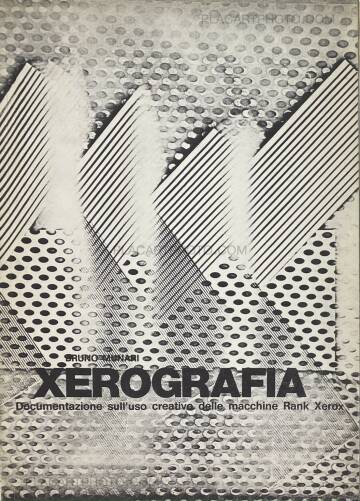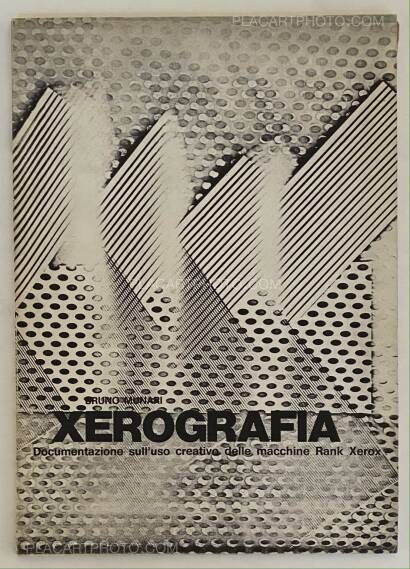XEROGRAFIA

Bruno Munari
XEROGRAFIA
Photographs: Bruno Munari
Publisher: self published
52 pages
Year: 1970
Comments: Softcover, numerous b&w illustrations, preserved in very good condition! Rare artist's book!
Book produced on the occasion of the XXXV Venice International Art Biennale, 1970. Munari was one of the first artists to use these machines creatively. "The results of the most advanced scientific and technological research, although generally understood with very different functions, can offer unexpected means to the creative operation, and open up a rich and fascinating discourse in the area of artistic research".
Focusing on Munari’s experiments with the Xerox 914 Machine, which began in 1963 and would continue throughout his entire career, the presentation brings a selection of works documented in his seminal book “Xerografia: Documentazione sull’uso creativo delle macchine Rank Xerox (Xerography: Documentation of the creative use of the machine Rank Xerox)”. Published in conjunction with Munari’s participation in the 1970 Venice Biennale, to which Munari contributed a Xerox machine to an experimental laboratory within the Biennale, the book provides instructions on the many ways to subvert the commercial machine’s function to create original images and artworks. Ranging from abstract to figurative, Munari’s Xerox works distort the original subject as he moved images across the devices surface for the duration of the scanning process.
In his prolific, 70-year career, Bruno Munari became known for various contributions to art, industrial design, film, architecture, art theory, and technology—including an early model of the portable slide-projector. He liked to (falsely) claim that his name meant “to make something out of nothing” in Japanese. Munari’s principles and beliefs were built upon his early involvement in the Futurist movement, which he joined at the age of 19 using the pseudonym “Bum.” During the 1930s, Munari began to move towards Constructivism, particularly with his kinetic sculptures, Useless Machines (begun 1933), meant to transform or complicate their surrounding environments. Throughout his career, Munari was captivated by both a sense of whimsy and the manipulation of artificial light. After World War II, Munari also developed radical innovation in graphics, typography, and book publishing, through the latter creating pieces he would call Useless Books.












more books tagged »Artist's book« | >> see all
-
Walls Paper
by Gordon Matta-Clark
sold -
Archivio (Signed)
by Bruno Locci
Euro 400 -
Mont Fuji (EDT OF 5)
by Jean Pierre Joly
sold -
BATU DAN BANJIR (2 vols)
by Miranda Devita Kistler
sold -
Vues Minuscules (V) (EDT OF 5)
by Louise Narbo
Euro 120 -
Suits vs. Facts & Fiction (Numbered edt of 150)
by Katja Stuke
sold
more books tagged »abstract« | >> see all
-
Matter waxed (Unique copy)
by Daisuke Yokota
sold -
Outskirts
by Daisuke Yokota
sold -
CTY (numbered copy)
by Antony Cairns
sold -
Shukei
by Nobuyoshi Araki
sold -
Abstracts
by Collective
sold -
TYO2 - PAPER VERSION (SIGNED)
by Antony Cairns
sold
more books tagged »xerox« | >> see all
-
Site
by Daisuke Yokota
sold -
D&A
by Collective
price on request -
Kingdom I-IV (Signed)
by Chiara de Franciscis
sold -
SET OF LINGER (SIGNED) + TEIKAI + IMMERSE (SIGNED)
by Daisuke Yokota
sold -
Paris Fragments 2017-2023 (EDT OF 3)
by Paul Grund
Euro 1200 -
SET OF LINGER (SIGNED) + TEIKAI + IMMERSE (SIGNED)
by Daisuke Yokota
Euro 750
more books tagged »italian« | >> see all
-
Taedium
by Attilio Solzi
Euro 22 -
"Signore e signori qui si da inizio al gioco"
by Bruno Locci
sold -
Paolo Baratella
by Paolo Baratella
sold -
Atlante
by Luigi Ghirri
sold -
I CINESI
by Caio Garrubba
sold -
Pathos (SIGNED)
by Giorgio Negro
sold
Books from the Virtual Bookshelf josefchladek.com


























;jpg)

_;jpg)


 Facebook
Facebook Instagram
Instagram